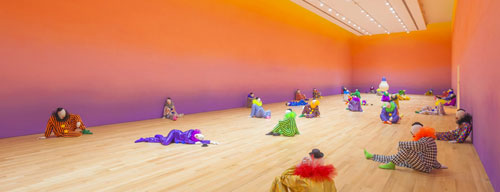It is always fascinating to watch patriarchy take care of its own. A major retrospective of Carl Andre is about to open at Dia and first off let me just say that it looks like it will be a good exhibition, maybe a really good exhibition, one with some interest to contemporary artists struggling to reconcile the real, theory or something like rigor with materiality.
Now for the patriarchy takes care of its own side of the story: there are many people in the New York artworld who believe that Carl Andre threw his wife Ana Mendieta out the window of their thirty-fourth floor apartment at 300 Mercer Street in the Village, September 8, 1985. At the time of the event and of Andre’s trial for second degree murder, people were divided by personal loyalties that transcended even dearly held shared political beliefs, so that not just prep school classmates such as Frank Stella, Andre’s dealers (Konrad Fischer and Paula Cooper), and ex-wife, but also some major feminists including Lucy Lippard sided with Andre because of their personal relationships with him, romantic and otherwise. Old friendships were shattered by which side people testified for at the trial, the defense or the prosecution. I strongly recommend Robert Katz’s 1990 book Naked By the Window: The Fatal Marriage of Carl Andre and Ana Mendieta. It’s really a fascinating book, a rich view of the New York art world at the time, especially if one knew even a few of the cast of characters, which I did, it is very layered, both objective and passionate, impressionistic in structure but very well researched, and convincing. The point where Assistant DA Elizabeth Lederer stood at the window and considered what had happened from the point of view of how short Mendieta was and how high the window sill was, stands out in my memory. The other thing that stands out in my memory of the story as told in the book is when Frank Stella writes a personal check for a quarter of a million dollars to post bail for Andre: “Ordover [Andre’s attorney] was called back and told that the entire quarter of a million in cash could be picked up at once at Stella’s bank.” (Katz, 85). The forces of patriarchy at work.
OK so then flash forward to December 5, 2011 when the New Yorker published “The Materialist,” a Calvin Tomkins profile of Andre, which was a kind of laying of the ground work for the Dia show. One of the basic premises of the profile was laid out by Andre’s current wife at the outset, that Andre has short-term memory problems as the result of a fall a few years ago, might be vague about a lot of stuff, bla bla.. So that’s patriarchy at work, first, creating a softer image, calling for sympathy, although in fact in the article Tomkins noted that finally he detected no signs of any memory problems.
Tomkins did point out that some of the women who were Andre loyalists were former girlfriends, but at the same time if you read the article it sounds like “some feminists” thought he was guilty and would harass him if they saw him in public places–that is, the implications is that only feminists thought he was guilty, you know, those harpies, whereas in fact the judge’s wording of the verdict (and implications in Katz’s text based on interviews) suggested a relation to the judgement available in British jurisprudence but not in the US, that is, what would have been a verdict of “not proven,” meaning he probably did it, but in the end the verdict was “I have concluded that the evidence has not satisfied me beyond a reasonable doubt that the defendant is guilty.” It was a “he said” situation, there would be no “she said.”
Then today, May 5, 2014, print copy, New York Times, full court press, “Minimalist Retrospective Gets a Master’s Touch,” installation of the show at Dia, Carl Andre is depicted completely differently, as perfectly sharp, no memory problems, totally on top of the installation of the show, “he is as quick-witted and dryly caustic as he was said to be in his youth.” Which is it? Short term memory loss but sharp as a tack when it comes to his retrospective?
I posted a version of this post on Facebook this morning, jumping up from breakfast after reading the New York Times article, and there has been a passionate response (I’ve made the Facebook post public so that the comments thread can be accessed by anyone who is on Facebook ). Some of the comments and also private messages to me were fascinating as they reflected some of the splits of opinion which had riven the artworld at the time. One message to me quoted Richard Prince’s view apparently as expressed in his stream of consciousness blog entries BIRDTALK, “I don’t know what happen to Carl Andre’s wife. No one will. Lawrence Wiener says Carl didn’t have anything to do with her death, and that’s enough for me.” [I take this quote of Richard Prince in the same light one may take his Playboy joke paintings, as actual sexism or as satire, take your pick or take both]. Others recalled details from the trial, or related personal experiences of what a violent drunk Andre could be (presumably back in the day, before he became a dithery retiree). Another person mentioned an art project by Michael Stevenson, which apparently was based on Katz’s book, and included “a ‘sculpture’ that was a scale model of the window sill,” (unfortunately no image of this work could be found in a Google image search). Another pointed out that “It would seem that the powers that be were waiting for a generation to literally ‘pass’; some of us, however, have confounded them, with our memories fully intact.”
It is an old story that some very good art is made by some very awful people and that people are both good and bad, but it is really important that the story be told, not just that it happened, but the way Carl Andre was protected and continues to be.







